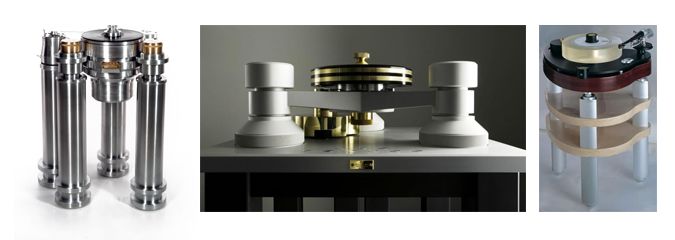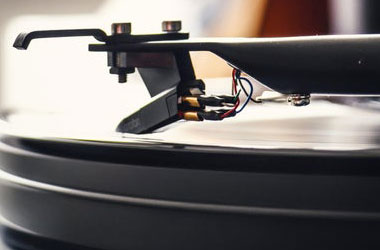Part 4 – Turntable placement and related issues
Turntable placement and related issues
Turntables are actually easy devices to understand as far as their functioning is concerned. The groove of the record and its shape over its entire length cause the stylus that is placed in it to move up and down, and from side to side, as the platter rotates. This movement is translated into tiny electrical signals inside the cartridge that then travel through the arm wiring to the phono stage where they are converted into a recognizable and audible sound through the amplifier and ultimately the speakers. Effectively the stylus is subject to vibration that is initiated by the shape and form of the groove walls. The reason why turntables have suspensions, or have a very high mass (the two main types of design) is to isolate external vibration or interference. For instance, should the turntable be placed on a surface that is prone to vibration, unwanted vibration (not caused by the groove wall information), will muddle the sound and create a totally inaccurate sound through the system. In poorly designed mass-market turntables even basic finger tapping on the plinth will cause a loud dull thump to be heard through the system. In the case of a suspension design the aim is to isolate the noise and negate or drain it away, in the case of a heavy mass the aim is to simply nullify and counteract it.
The problem with vibration is that the stylus cannot differentiate between vibration caused by the groove wall or vibration from external sources. It simply is present at the same time. The inevitable conclusion to the same signal running through the system twice (let’s assume that the system is played loud enough for the sound to travel through the entire electronic chain and re-enter the turntable through a rickety stand or suspect mounting surface), is a loud and uncomfortable hum or howling sound that drowns out sound. It stands to reason that the stylus should be the only item acting and responding to the movement, without any external stimuli.
In order to isolate the turntable from its surroundings (and various factors that might induce additional and unwanted movement), a variety of support devices and stands have been developed from a variety of manufacturers. In principle certain types of materials might benefit certain types of turntables, and in practice some sound better than others. Generally high mass designs are prone to work better with high mass designs, and suspension-type designs are prone to work well with low mass yet rigid designs, as they store and release very little levels of energy. There are always exceptions to this rule, but generally this is a fairly rule of thumb.
Very often one finds that turntables have integral stands that form part of their functioning and should ideally be used with them for optimum performance, and in certain cases the stand or support must be used as it is crucial to the performance parameters. Examples of this can be seen here with the Goldmund Reference, the Vyger and also the Opera Audio units.

The majority of designs are fairly easily accommodated on aftermarket devices. A wide variety of stands and wall-brackets should work on the majority of turntables. Wall-brackets are very simple and effective solutions when space might be at a premium, or more importantly, when a suspended wooden floor is used. Devices like CD players are usually more forgiving when mounted on stands in such conditions, but there is no reason why a wall-bracket cannot be placed above the system to create a singular visual entity. A good example would be of the Rega bracket, a simple yet effective device suited specifically to Rega turntables. Custom stands can be made by Sound Structures, to a very high level of fit and a choice of finish, as the example herewith shows:
In many cases the surface that the turntable is going to be mounted on is quite sturdy and stable, yet further isolation might still be required. In cases like this there are separate shelves and inserts that can be placed between the turntable and the surface itself. A standard rectangle of granite, wood, MDF, or a composite sandwich of different materials can be used, that will give various degrees of isolation and absorption. Sorbothane and similar materials can be used under certain rectangular boards.
From time to time ingenious, wacky and downright weird solutions also surface that work very well. Here are some of them:
Placing a solid slab of marble or concrete on top of an inflated bicycle tyre inner tube.
Placing a turntable without suspension in a large bucket filled with sand (this might be tricky one as the slightest movement might alter the level of the unit).
Placing cork feet under the actual feet of the turntable.
Through the years well-known names like Mana Acoustics built stands that were multi-tiered and could be stacked to a level of the customers liking, and of course, budget permitting. Russ Andrews Turntable stands used to be the correct choice, and many people thought Ikea stands were not only practical, but actually preferred their iconic and unique appearance. Fortunately this discussion has never pretended or claimed to be overtly technical or scientifically on a totally empirical level only, so if a solution works and the noise floor is lowered, please feel free to continue using it, without the need of having to feel that it must be justified. You certainly will hear the difference that better isolation can make, irrespective of what that solution is.
Up to this point we have spoken about isolation from the bottom and underneath the turntable, but what about on the turntable itself, like the platter? All turntables have the motor unit and base as one entity and the arm and cartridge as the other entity. The common denominator where forces are joined is actually the record itself once the stylus is lowered and playing begins. In many cases the platter is topped with a felt or rubber mat, primarily to create a better and more conducive environment for the stylus to dig out information unimpeded. The felt mat on certain turntables does not interfere with the frequency response and also offers a degree of isolation that does not affect the performance, e.g. Linn LP12 and others. In many cases the idea behind a rubber mat is to create a stable surface that creates some form of isolation from motor vibration, etc. But certain platters are made of materials that closely resemble the actual same feeling and damping properties as the vinyl itself. Platters made of acrylic, Lexan and other materials have unique properties that create uniform damping with the record in position and playing so that the frequency response is extended and less noisy. Anybody that has experienced the irritation of a felt mat flying off a turntable due to anti-static build-up will attest to the fact that add-on accessory platters like The Funk Firm’s Achromat is a wonderful solution. Two versions exist and the suspension would simply have to be heightened by either 3mm or 5mm, depending on which option is used. The resultant sound is superbly detailed and the frequency response is extended, and the noise floor is lowered at the same time. These mats will work on a wide variety of turntables and the cost is not high. Do some experimenting and be sure to reap the rewards of better sound and more natural presentation.
In our next installment we will be addressing the differences between the different types of cartridges, and explaining generally used terms and their meanings and implications.


Recent Comments